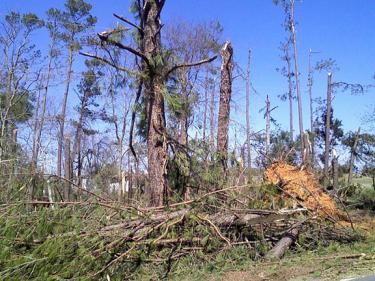How Tornadoes Affect Your Forest
The steps that you take in the aftermath of a tornado can make a big difference for your forest.
Tornadoes can devastate woodlands—not just because of their powerful winds, but also because of the flooding and large hail that can accompany them.
Some of the more common injuries your trees can sustain in a tornado are:
- Breakage. This is the most common injury. Limbs and trunks can break in the wind or under hail, leaving trees vulnerable to fungi and other invaders.
- Twisted trunks. A tornado’s spinning winds can actually twist and separate a tree’s wood fibers. This twisting might not be easily visible; with some trees, you can only tell at harvest or, in the case of pines, when pitch flows along the trunk.
- Bent trees. Bent hardwoods often survive, but pines bent to the point of cracking can fall prey to disease.
- Root damage. Uprooted trees become vulnerable to fungi, insects and, over time, shifting and instability.
- Wounds, including debarking. Impact from hail or falling trees or branches, debarking by the wind and other injuries can leave trees susceptible to disease or pest insects.
- Standing water. Standing water from flash floods can change the soil composition or deplete the soil of oxygen, both of which can injure or kill trees.
- Wildfire and disease risk. The piled up, broken trees left behind by a tornado tend to be more vulnerable to both wildfire and pests. Invasive species also like disturbed sites.
Beyond the damage to your actual timber, tornadoes can also destroy roads through your property, alter stream flow and drainage, and create safety hazards for visitors.
All this damage may sound overwhelming, but your woods can recover. And the steps you take in the aftermath can make a big difference in that recovery.
Previous page
Next page
How can I get more tips?
It’s simple! Enter your email below.

